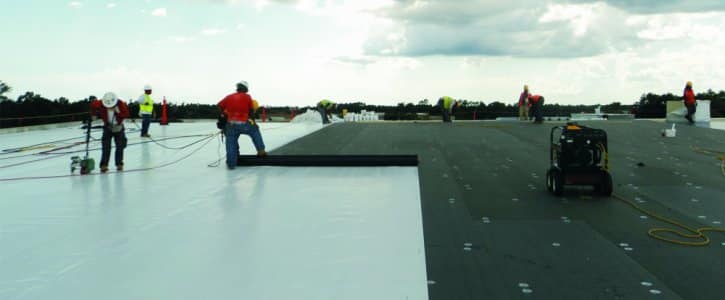
A roof leak can stoke panic in building owners and facilities managers who don’t know if the repairs will be quick and economical – or long and costly. All owners and managers should know how to assess the scale of an issue to choose the right solution – one that sees the building repaired efficiently and effectively, without wasting time or resources. So, how does one assess an issue and determine if it is high, medium, or low priority?
Step 1: Examine the Problem and Identify the Source
All leaks are different: they can come from tiny punctures that can be patched quickly, or they can be the most visible symptom of significant structural damage. When owners and managers discover a leak, they must first determine the scope of the problem by identifying its cause before they can choose the appropriate solution. For instance, did any external events (such as a major storm or flood) occur that might have exacerbated the issue?
If recent events can be ruled out, owners and managers should gather as many facts as possible. When does water appear? How much? For example, if the leak doesn’t appear when it rains, it might not be a leak at all, but instead an issue with the plumbing or HVAC system. Upon noticing a leak, building managers should immediately do the following:
- Mark the place of the leak on the floor with tape. This can be a substantial timesaver for your roof contractor: instead of investigating an entire 140,000 square foot roof they can immediately narrow their focus to a 20 x 20 area.
Document as much information as possible to assist your roofing contractor and prime them for success in preparing the roof system for repair.
The building’s maintenance records are another good place to gain insight, especially if an issue was previously identified in an inspection but wasn’t dealt with right away.
Step 2: Determine an Appropriate Solution That Fits the Need and Budget
When the facilities manager or owner has identified the cause and scope of the issue, the next challenge is to devise an appropriate solution that not only safely resolves the problem, but is also in-line with the owner’s needs, goals, and finances.
Consider the following:
- The roof’s age
- The previous maintenance performed on the roof
- The building’s purpose
- The owner’s intentions for the building
For example, if the owner plans to sell in the near future, perhaps repairs should be limited to only the most immediate, necessary stopgap measures. However, if the owner plans to hold the building as a long-term investment, major repairs may be the best way to extend the roof’s life and boost the building’s value. If the problem is big enough — like saturated insulation or major wind uplift problems — the up-front cost of a full replacement could make more economical sense than the cumulative cost of many smaller repairs.
Likewise, buildings that house people or expensive merchandise clearly need a full-scale, immediate fix, whereas empty buildings or those storing objects unaffected by water exposure might be prime candidates for a temporary fix, while the owner plans and budgets for a more permanent solution in the long-term.
2 Steps to Resolve a Leak: Assess, Then Plan
Before owners or facilities managers jump in to a solution when confronted with a surprise leak in their roofs, they should first determine the source of the leak and scope of the problem. With the right information, it’s easier to assess one’s options and develop a solution tailored to the owner’s needs.
